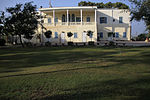Hof Ashkelon Regional Council
1950 establishments in IsraelHof Ashkelon Regional CouncilRegional councils in Israel

Hof Ashkelon Regional Council (Hebrew: מועצה אזורית חוף אשקלון, Mo'atza Azorit Hof Ashkelon, lit. Ashkelon Coast Regional Council) is a regional council in the Southern District of Israel. As of the year 2019, its population is around 18,000.The council is bordered to the north by Be'er Tuvia Regional Council, to the east by the Be'er Tuvia, Lakhish, Shafir and Yoav Regional Councils, to the south by Sha'ar HaNegev Regional Council and the Gaza Strip, and to the west by Ashkelon and the Mediterranean Sea. Its average elevation is 54 meters above the sea level.
Excerpt from the Wikipedia article Hof Ashkelon Regional Council (License: CC BY-SA 3.0, Authors, Images).Hof Ashkelon Regional Council
Hof Ashkelon Regional Council
Geographical coordinates (GPS) Address Nearby Places Show on map
Geographical coordinates (GPS)
| Latitude | Longitude |
|---|---|
| N 31.717 ° | E 34.633 ° |
Address
7950500 Hof Ashkelon Regional Council
South District, Israel
Open on Google Maps










